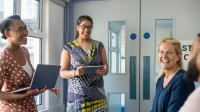Embedding Voice and Choice in Professional Learning
An important part of giving teachers a say in their professional learning is taking their feedback and acting on it.
In education, we talk a lot about inclusive and equitable practices in classrooms and the importance of optimizing student voice and choice through Universal Design for Learning (UDL). As a teacher who has been providing professional development (PD) for staff for nearly two decades, I am confident that professional learning also benefits from these shifts.
When we optimize teacher feedback to drive professional learning and use that feedback in our design process while offering flexibility and choice, we increase teacher efficacy and engagement. Before we shifted our PD model, less than 30 percent of staff reported that professional learning met their needs and supported them as educators. Now, we consistently have 95 percent reporting the same. The following process allowed our team to significantly increase teacher engagement.
3 Steps to More Engaging PD
1. As PD providers, ask for feedback. Our district, like many districts, is currently focused on learning more about inclusive practices and UDL. A recurring theme in this work is the importance of using student feedback to support the design of learning. As a leadership team, we committed to modeling the importance of learner voice by asking staff for feedback.
At the end of each professional learning session, we provide staff with a survey (they have the option to complete it digitally or in hard copy). We provide them with the goals of the session and ask them to rate their agreement on whether the goals were met. In the next section of the survey, we ask them to share what worked particularly well and what did not work for their learning. Lastly, we provide a space for educators to pose questions and note if they would like a response.
2. Once you have feedback, complete the feedback loop. We have been asking for feedback for years, but we were missing the most important part. We did not share how feedback impacted the design of subsequent sessions. To address this, we created a feedback loop and routine.
At the beginning of each session, we share feedback from the previous session and explain how that feedback impacted our work. At the beginning of each session, we show a slide that includes the following sections: what we learned from the participants’ feedback, what we have done differently, and what we have kept the same. We also build time at the end of the session for staff to complete the next feedback survey.
The impact of this practice was immediate. Nearly every staff member provides feedback on sessions, and they continually share how refreshing it is to be asked about their needs and then see them instantly acted upon.
3. Embrace the power of reflection. An important part of our learning was the power of reflection. We realized quickly that we were not going to be able to create learning sessions and just roll through them. Here are some things we learned during reflection:
- Be ready to rework questions. As we gathered feedback from staff, we found that we were sometimes asking the wrong questions. For example, in our first draft of surveys, we asked the staff if we had met our session goals, but we quickly learned that we needed a separate question for each goal and a space for teachers to share why or why not. This shift gave us more detail and allowed us to be more intentional about changes.
- Focus on actionable feedback. We learned that we needed to call out the evidence-based strategies we were modeling, such as discussion protocols, time to explore resources, and even the types of resources we provided. We began adding a list of the strategies and asking which strategies worked best for staff, which didn’t, and why. For example, early in this practice, we learned that some staff wanted time for personal reflection before participating in small group discussions. They also shared that too many resource choices during exploration was frustrating, so now we minimize options to two to four, consistent with research on the relationship between choice and intrinsic motivation.
- Shared design makes a difference. One powerful benefit that I did not anticipate was a sense of collaborative design. Once we started using staff feedback to guide our planning, the sessions had a feeling of shared ownership. We did not take feedback as personally as in our first sessions. We let staff know that the only way we could improve sessions was with their help. Staff was literally helping us craft the next learning experience with their feedback responses.
Next Steps
We aren’t done. Our journey as a staff has just started, but it feels like we are doing this together. Professional learning belongs to all of us. Just as we want classrooms to be student-directed, we need PD to be teacher-directed. Our staff has the same needs around engagement in their own learning as our students. They need to feel that they are listened to, they are valued, and they can contribute to the design of their learning experiences.
